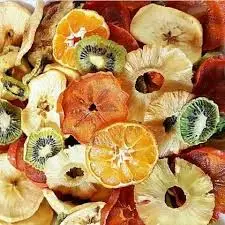
Everything You Need to Know About Fruit Freeze Dryers

Drying fruit has long been a traditional and effective method to increase the shelf life of fruits. However, challenges such as loss of nutritional value and changes in taste and color led scientists to develop a method that not only dries products with the highest quality but also significantly increases their shelf life.
With the introduction of fruit freeze dryers into the food industry, a huge revolution occurred. Thanks to its outstanding performance, this device is considered one of the most widely used freeze dryers. In this article, we will fully introduce you to the fruit freeze dryer, its structure, and how it works. We will also discuss the advantages and disadvantages of this method and finally provide some tips to guide you in purchasing a fruit and vegetable freeze dryer.
A fruit freeze dryer is an advanced device that removes moisture from fruits through a process called freeze drying. This involves freezing the fruit and then placing it in a vacuum, which allows the frozen water inside the fruit to sublimate directly from solid to gas. The result is dried fruit that retains its nutritional properties, flavor, and has a long shelf life. Freeze-dried fruits are commonly used in food products, desserts, and as raw materials in various dishes.
The fruit freeze dryer is a relatively complex machine with several components working together to perform the freeze drying process and produce high-quality dried fruits. The components vary depending on the type and function of the machine but generally include:
Freezing Chamber: This is where fruits are frozen and the freeze drying process begins by converting water to ice.
Vacuum System: Creates a low-pressure environment that allows the frozen water in the fruits to sublimate and separate from the product.
Condenser: Collects water vapor produced during sublimation and converts it back to solid form to prevent reabsorption into the fruit.
Heating System: Some machines use heating elements to speed up the sublimation and final drying.
Control Panel: Contains controls and sensors to manage and monitor temperature, pressure, and timing throughout the freeze drying cycle.
Steam Ventilation System: Removes evaporated moisture from the system to speed up the drying process.
Fruit freeze dryers can be categorized based on various factors like design, capacity, and manufacturer. Here, we classify them according to capacity:
Home Fruit Freeze Dryers:
These are suitable for home use or small-scale fruit drying. They are small in size with simpler operation and lower costs for purchase and maintenance.
Medium and Semi-Industrial Fruit Freeze Dryers:
Used for small commercial or medium-scale processing, these machines have larger capacity than home models but are not suitable for mass production.
Industrial Fruit Freeze Dryers:
Designed for large-scale production, these meet industrial standards and are ideal for big commercial operations. They have more complex and intelligent systems capable of handling large volumes and continuous production lines.
The freeze dryer removes moisture from products based on freezing and sublimation principles. The process involves:
Preparation of Fruits:
Some fruits require cleaning, washing, cutting, and sorting before entering the freeze dryer.
Loading Fruits into the Machine:
Fruits are placed on trays, usually metal with holes for better air circulation, arranged in uniform layers.
Freezing Stage:
The temperature is lowered to freeze the water inside the fruits, forming ice crystals in the cells.
Sublimation Stage:
The temperature is raised under vacuum conditions so ice crystals directly convert to vapor without passing through the liquid phase.
Final Drying:
Remaining moisture is slowly removed to ensure thorough drying.
Product Removal and Packaging:
Dried fruits are carefully packed to protect against oxygen and moisture, preserving quality and shelf life.
The drying time depends on factors such as fruit type, piece size, initial moisture, and device settings, ranging from a few hours to several days.
Preserves Quality: Maintains flavor, color, aroma, taste, and nutritional value by preventing chemical and enzymatic changes.
Long Shelf Life: Freeze-dried fruits can be stored for years without preservatives.
Lightweight: Removing moisture results in lighter fruits, easing transport and storage.
Easy Rehydration: Dried fruits regain their fresh state quickly when water is added.
Versatile Applications: Suitable for drying various fruits, vegetables, and other food products.
Higher Initial Cost: Advanced technology and higher energy consumption lead to higher upfront and operational costs.
Space Requirements: Industrial models require significant space and special equipment.
Longer Process Time: Multiple steps can extend the total drying time.
Texture Changes: Although rehydration is possible, some fruits may experience slight texture changes after freeze drying.